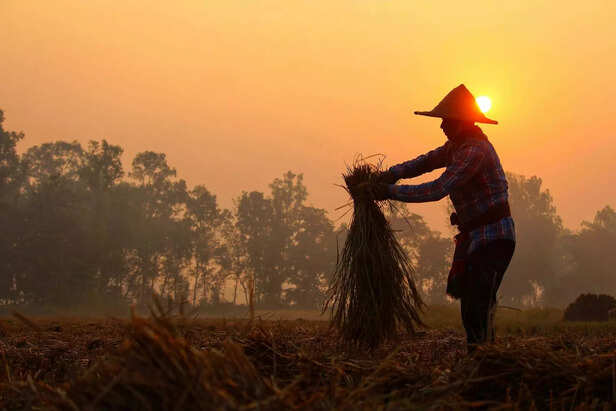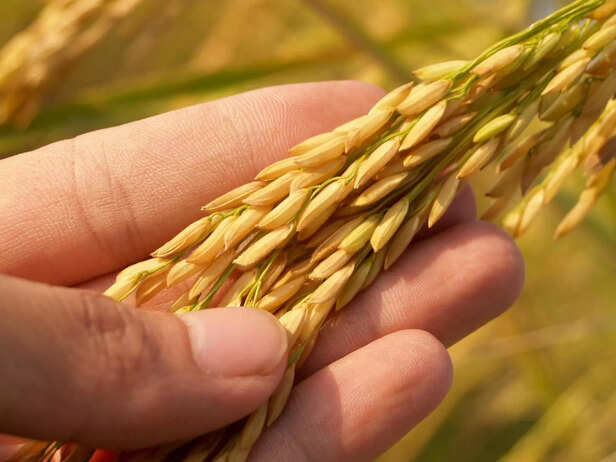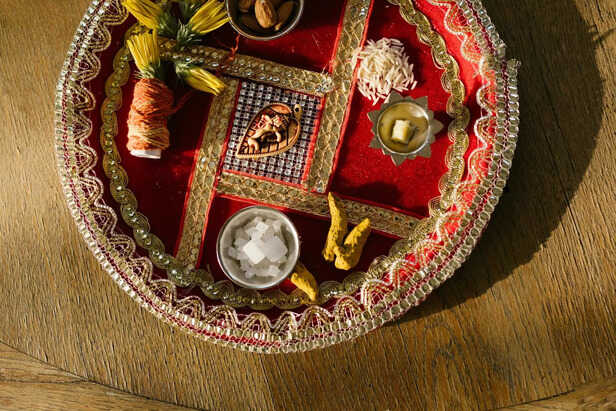Why Is Rice Always Used in Hindu Offerings and What It Really Means
Riya Kumari | Jun 26, 2025, 21:50 IST
Let’s talk about rice. No, not that dreamy Thai basil fried rice from your favorite takeout. I'm talking about that modest heap of uncooked, white grains sitting like a little sacred mountain on a banana leaf during Hindu rituals. The one you saw at your cousin’s wedding, your neighbor’s housewarming, and basically any pooja ever. Ever wondered why rice is always invited?
It’s easy to miss it. In the midst of the flowers, the incense, the chanting, the flame, your grandmother whispering mantras under her breath—it’s easy to overlook that small handful of rice placed with quiet care. No grandeur, no spectacle. Just… rice. But this is where it gets interesting. The loudest symbols in life aren’t always the ones wrapped in gold. Some of them sit in silence, soft-spoken but unshakable. Like rice. So why is rice always there? In temples, at weddings, before new journeys, and during final farewells? Because rice, in Hindu thought, is not just food. It is a witness. A message. A bridge between the seen and the unseen. Let’s pause here. Because this isn't just about rituals—it’s about how meaning hides in plain sight.

Rice is not decoration. It is declaration. It’s one of the few offerings that isn’t a luxury. It’s basic. Essential. It feeds millions daily without demanding attention. And in that lies its sanctity. When rice is offered in a ritual, it’s a way of saying:
"I give you what sustains me. I offer not what is left over, but what I live by."
It’s not the showy gesture of someone trying to impress the divine. It’s the quiet offering of someone who understands that the sacred begins with the simple. The grain of rice doesn’t perform. It just is. And that’s enough.

There’s a reason the rice used in rituals is raw. Not cooked. Not flavored. Just as it came from the earth. Because rawness carries something cooked things lose—possibility. Uncooked rice is pure potential. It hasn’t taken a final shape. It could become anything. When we offer it, what we’re really offering is our future, our hopes, our readiness to be shaped. We’re saying:
"I’m not finished. I’m in the middle of becoming. And I offer that journey to something higher."
In that sense, rice becomes a metaphor for us.

When rice is mixed with turmeric and offered as Akshata—that which is unbroken—it becomes more than a blessing. It becomes a reminder. That what we truly seek in life is wholeness. Not perfection. Not success. Not applause.
But the feeling that we are intact. That we are enough as we are, even in our chaos, even in our becoming. Akshata is placed on our heads not to mark us, but to remind us: You are whole, even when you don’t feel it.

Hinduism, at its core, has always revered the symbolic. Fire isn’t just fire. Water isn’t just water. And rice isn’t just rice. It’s the smallest act with the deepest meaning. And that’s what makes it powerful. We live in a world obsessed with big gestures. But rice teaches us that reverence can live in a grain. That devotion doesn’t need noise. That simplicity, when done with awareness, can hold more power than anything loud or grand.
And perhaps, the gods accept rice not because of what it is, but because of how it’s given—without ego, without excess, just… honestly.
So, next time you sit for a pooja or see someone place rice on a deity’s feet, look a little closer. You’re not just watching a ritual. You’re watching a lesson in surrender. In humility. In sacred simplicity. Because when we offer rice, we’re not just offering food.
We’re offering trust. We’re saying:
"Here is my sustenance. Here is my potential. Here is everything I am becoming."
And that, truly, is what makes a grain sacred.
Rice Is Life, In Its Most Honest Form

Rice harvest
( Image credit : Pexels )
Rice is not decoration. It is declaration. It’s one of the few offerings that isn’t a luxury. It’s basic. Essential. It feeds millions daily without demanding attention. And in that lies its sanctity. When rice is offered in a ritual, it’s a way of saying:
"I give you what sustains me. I offer not what is left over, but what I live by."
It’s not the showy gesture of someone trying to impress the divine. It’s the quiet offering of someone who understands that the sacred begins with the simple. The grain of rice doesn’t perform. It just is. And that’s enough.
Raw Rice = Untouched Potential

Rice grain
( Image credit : Pexels )
There’s a reason the rice used in rituals is raw. Not cooked. Not flavored. Just as it came from the earth. Because rawness carries something cooked things lose—possibility. Uncooked rice is pure potential. It hasn’t taken a final shape. It could become anything. When we offer it, what we’re really offering is our future, our hopes, our readiness to be shaped. We’re saying:
"I’m not finished. I’m in the middle of becoming. And I offer that journey to something higher."
In that sense, rice becomes a metaphor for us.
Akshata: The Wholeness We Secretly Seek

Rice
( Image credit : Pexels )
When rice is mixed with turmeric and offered as Akshata—that which is unbroken—it becomes more than a blessing. It becomes a reminder. That what we truly seek in life is wholeness. Not perfection. Not success. Not applause.
But the feeling that we are intact. That we are enough as we are, even in our chaos, even in our becoming. Akshata is placed on our heads not to mark us, but to remind us: You are whole, even when you don’t feel it.
The Bigger Picture Hidden in a Tiny Grain

Puja thali
( Image credit : Pexels )
Hinduism, at its core, has always revered the symbolic. Fire isn’t just fire. Water isn’t just water. And rice isn’t just rice. It’s the smallest act with the deepest meaning. And that’s what makes it powerful. We live in a world obsessed with big gestures. But rice teaches us that reverence can live in a grain. That devotion doesn’t need noise. That simplicity, when done with awareness, can hold more power than anything loud or grand.
And perhaps, the gods accept rice not because of what it is, but because of how it’s given—without ego, without excess, just… honestly.
The Grain That Teaches Us How to Offer Ourselves
We’re offering trust. We’re saying:
"Here is my sustenance. Here is my potential. Here is everything I am becoming."
And that, truly, is what makes a grain sacred.
